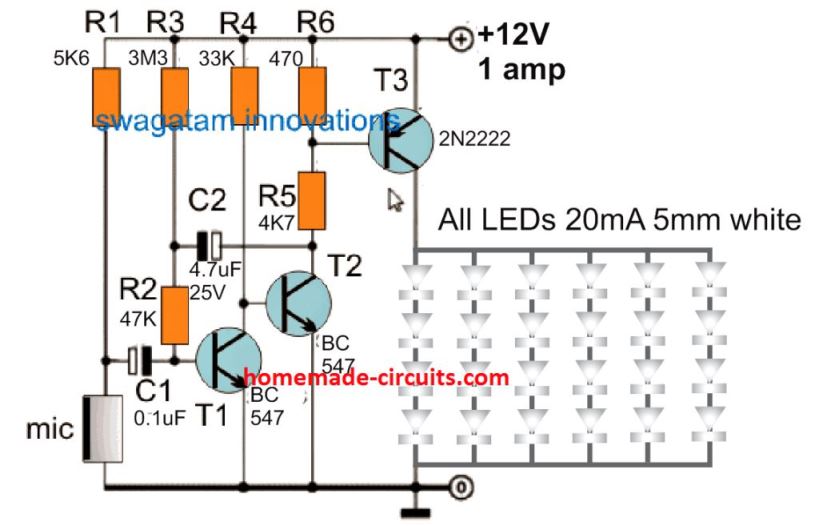A highly sensitive sound activated LED lamp circuit can be built using just a few transistors and resistors.
The circuit is actually a high gain MIC amplifier circuit which amplifies the external sound hitting the MIC. The amplified signal is then used to momentarily illuminate a bunch of LEDs.
What does the Circuit do?
Basically, this sound activated LED lamp works in the following manner:
When a sound hits the MIC, the MIC converts it into tiny electrical pulses. These tiny pulses are then amplified into larger voltage and current by a couple of transistor stages.
This amplified voltage and current is then applied to a set of LEDs. The LEDs thus respond and switch ON each time sound vibration is detected by the MIC.
The circuit has a delay OFF feature which ensures that the LEDs remain ON for a second or two even after the sound is no longer available on the MIC.
Circuit Description

Parts List
- Resistors are all 1/4 watt 5% CFR
- 5.6K = 1
- 47K = 1
- 3.3M = 1
- 33K = 1
- 4.7K = 1
- 470 ohms = 1
- Capacitors
- 0.1uF Ceramic Disc = 1
- 4.7uF/25V electrolytic = 1
- Transistors
- BC547 = 2
- 2N2222 = 1
- LEDs 3.3 V, 20 mA = 24
- MIC, electret type = 1
Referring to the above circuit diagram, the working of the sound activated LED lamp can be understood with the following points.
Transistor T1, capacitor C1, resistors R1, R2, R3 together form a simple electret MIC preamplifier circuit.
The basic function of this stage is to boost the minute electrical pulses from the MIC into a relatively larger voltage pulses.
Transistor T2 and T3 along with the resistors R4, R5, R6 are configured to work like a power amplifier.
The job of this power amplifier is to boost the preamplified pulses at the collector of T1 into significantly larger voltage and current output.
This amplified voltage and current is finally used to drive the set of LEDs, connected at the collector of transistor T3.
Resistor R3, together with capacitor C2 are used to add a delay OFF feature on the LEDs. This ensures that the LEDs remain illuminated for some seconds even after the sound vibrations cease to exist on the MIC.
C2 value can be increased or decreased to correspondingly increase or decrease the delay OFF timing of the LED switch OFF period.
The sensitivity of the circuit can be adjusted by adjusting the value of the R1 resistor. Higher values will mean lower sensitivity and vice versa.
LED Configuration
In the proposed circuit, 4 LEDs are used in series on each of the strings, and 6 of these strings are connected in parallel.
The LED strings can be seen without a current limiting resistor. This is because the 12V DC supply is presumed to be constant here. Considering each LED is rated at 3.3 V, 4 in series constitutes 3.3 x 4 = 13.2 V, which is lower than 12V, so no limiting resistor is required.
If your 12V DC is not constant, then you can add a current limiting resistor with each string, using the following formula:
R = (Supply DC - LED total forward voltage) / LED Current
R = (Supply DC - 13.2) / 0.02
The 0.02 represents the LED current of 20 mA, for the LED strings.
Post your comments here and get guaranteed replies. Comments must be related to the above article.